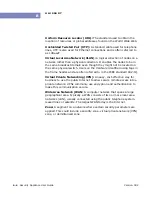
. . . . .
G L O S S A R Y
Version 3R2
Security Appliance User Guide
B-5
Message Digest 5 (MD5):
A one-way hash function. This hash function
takes a variable length message and formats it to a fixed length using a
16-bit key to produce 128-bit hash.
Media Access Control (MAC) Address:
The hardware address that
uniquely defines each Ethernet interface in use on a local area network
(LAN). The MAC address commonly refers to the Ethernet address or a
node on a LAN. When connected to the Internet, the MAC address tracks
the IP address of a node. The freeGuard Blaze 2100 software creates a
table that references the MAC address to a known IP address.
NAT-Traversal (NAT-T):
Network Address Translation method that
allows IP Security (IPsec) packets to pass through a NAT device that
might be along its path by detecting and encapsulating the Internet Key
Exchange (IKE) packets as User Datagram Protocol (UDP). The most
common port used to perform NAT-T is UDP port 500.
Netmask:
Identifies the sub-network and the hosts that are available.
An example, 10.0.0.0 255.255.255.0 (10.0.0.0/24) refers to all hosts in
the 10.0.0.0 subnet.
Network Address Translation (NAT):
A standard that allows
machines on a local area network (LAN) to use a set of IP addresses for
internal use and another IP address or set of addresses to access
external traffic. Most NAT devices are used to enable multiple machines
on a LAN to access the Internet using a single external address.
Network Time Protocol (NTP):
Protocol built on top of TCP/IP and
used to synchronize local timekeeping with reference to radio, atomic, or
other clocks located on the Internet. This protocol is capable of providing
accuracies typically within a millisecond to a network device.
Next Hop:
An IP address used in a routing table to enable forwarding of
traffic for a specific network.
Packet:
A unit of data routed between a source and destination over the
Internet or a packet-switched network.
Public Key Infrastructure (PKI):
PKI is designed to be used with
IPSec instead of PSK and Manual Key. It provides a higher level of
security.
Port Address Translation (PAT):
Translates the original source port
number to a different, randomly assigned port number.
Port Mapping:
Changes the original destination port number on a
packet to a different, predetermined port number.




























